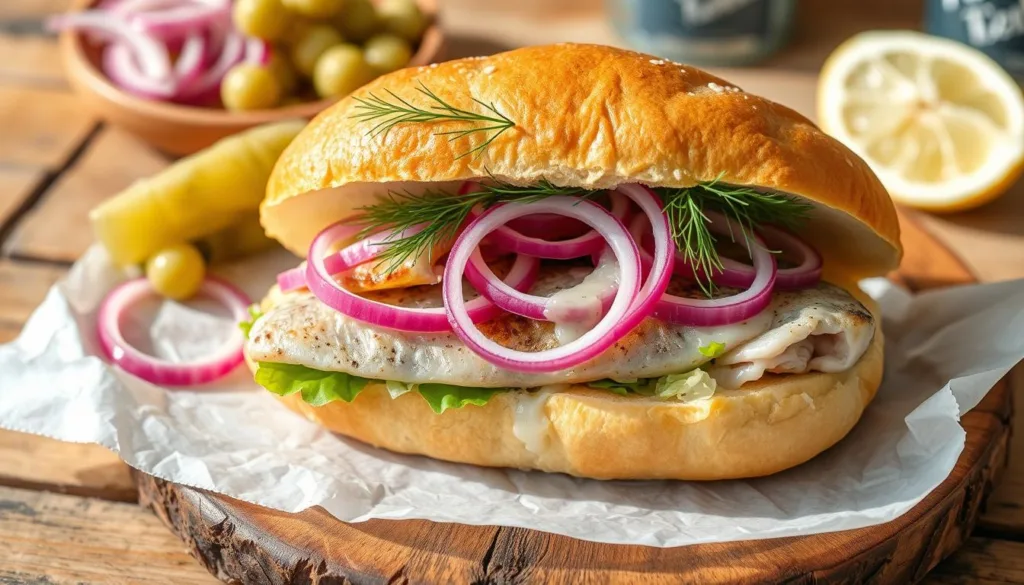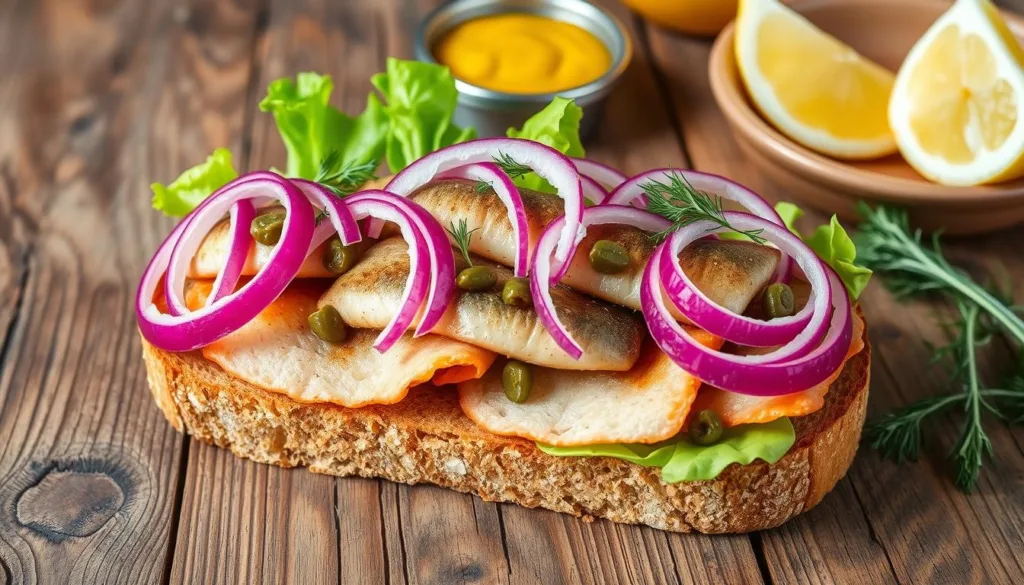matjesbrötchen recipe :
As summer ends, the smell of sea air and fresh bread fills Northern Germany’s streets. This is when Matjesbrötchen, a famous German fish sandwich, shines. Growing up by the Baltic Sea, I remember enjoying this treat. It brings back memories of the sea’s flavors and home’s comfort in one delicious bite.
Matjesbrötchen is more than a sandwich; it’s a symbol of Germany’s coastal culture. It shows the hard work of harbor workers who used it as a snack. From old docks to today’s Hamburg markets, this sandwich has won many hearts and taste buds.

Table of Contents
Key Takeaways
- Matjesbrötchen is a classic German fish sandwich featuring pickled herring, onions, and fresh bread.
- The tradition of Fischbrötchen dates back to the 18th century in Germany’s coastal cities, particularly Hamburg.
- Matjesbrötchen is a beloved Northern German delicacy, perfect for a quick lunch or appetizer.
- Pickled herring is a nutritious ingredient, rich in vitamins and minerals like vitamin D, vitamin B12, and selenium.
- This recipe will guide you through the history, ingredients, and preparation of this iconic coastal dish.
Introduction to German Fish Sandwiches (Fischbrötchen)
Fischbrötchen, the beloved German fish sandwiches, have a fascinating history. They date back to the 19th century. These tasty snacks were a convenient meal for harbor workers, filling and flavorful.
As coastal towns and resorts grew in popularity, Fischbrötchen became more than just a snack. It became a regional delicacy in northern Germany. Today, you can find these fish sandwiches at festivals, Christmas markets, and even Oktoberfest.
The Rise of Coastal German Street Food
The Fischbrötchen’s origins are in northern Germany’s port cities. Harbor workers needed a quick, satisfying meal for their long shifts. These fish sandwiches, made with fresh catch, became a beloved street food.
Celebrating the Culinary Traditions of Northern Germany
The Fischbrötchen holds a special place in northern Germany. In cities like Hamburg, it has a long history. Local eateries and street vendors proudly serve these iconic sandwiches.
Today, the Fischbrötchen is a cherished part of the region’s culinary identity. It’s found on menus in coastal restaurants, festivals, and even Oktoberfest.
The Fischbrötchen’s popularity and cultural significance in northern Germany are clear. It’s a simple yet delicious regional specialty. As you explore German coastal cuisine, be sure to try the Fischbrötchen. It’s a true taste of the country’s maritime heritage.
What Makes Matjesbrötchen Special
Matjesbrötchen is a favorite German fish sandwich. It uses Matjes herring, a special pickled herring. Matjes are caught before they’re fully grown, making them milder and tenderer than regular herring.
The mix of soft, marinated Matjes herring and crunchy German bread rolls is amazing. Sharp, raw onions add a zesty touch, balancing the rich fish perfectly.
| Matjes Herring | German Bread Rolls | Traditional Toppings |
|---|---|---|
| Harvested before sexual maturity Mild, tender flesh Marinated in a special brine | Crusty, artisanal bread rolls Typically made with rye or wheat flour Providing a crunchy base | Raw, thinly sliced onions Tangy, piquant flavor Complementing the rich herring |
The Matjesbrötchen sandwich is a mix of textures and flavors. It’s a beloved treat in Northern Germany. This special sandwich has won the hearts of both locals and visitors, making it a true German street food icon.

“The Matjesbrötchen is a true celebration of the coastal culinary heritage of Northern Germany.”
Essential Ingredients for Authentic Matjesbrötchen
To make the perfect Matjesbrötchen, you need a few key ingredients. The star is the Matjes herring or Bismarck herring. These young, mildly pickled herrings have a delicate, slightly sweet taste.
The bread is also crucial. You’ll need crisp, crusty bread rolls (Brötchen). They contrast well with the soft, marinated fish. Traditional toppings include raw onions and pickled gherkins. They add a refreshing crunch and tangy punch to balance the rich herring.
| Ingredient | Description |
|---|---|
| Matjes Herring | Mild, young, pickled herrings with a delicate, slightly sweet flavor. |
| Crusty Bread Rolls | Crisp on the outside, soft on the inside, providing the perfect base. |
| Raw Onions | Thinly sliced raw onions add a refreshing crunch and pungent flavor. |
| Pickled Gherkins | Tangy, crunchy pickled gherkins complement the richness of the herring. |
While these core ingredients are essential, some regional variations may also include toppings like remoulade, ketchup, or tartar sauce. These additions can enhance the flavor profile. The key to an authentic Matjesbrötchen is the quality and freshness of the ingredients.
Traditional Preparation Methods
Making a real German Matjesbrötchen, or fish sandwich, is a special process. It starts with cutting the bread roll in half. Then, you put lettuce on the bottom half. After that, the marinated herring goes on top.
Next, add raw onions and pickled gherkins for extra taste and crunch. Some places might add fried onions or sauces like remoulade or horseradish. Finally, put the top half of the bread back on to finish the Matjesbrötchen.
This way, every bite is perfect. You get the salty briny pickled herring, the soft bread, and the fresh vegetables and condiments.
| Key Preparation Steps |
|---|
| 1. Slice bread roll horizontally |
| 2. Spread condiments on both halves |
| 3. Add a layer of lettuce |
| 4. Place marinated herring |
| 5. Top with raw onions and pickled gherkins |
| 6. Add optional fried onions or sauces |
| 7. Reassemble the sandwich |
By using these steps, you can make a delicious German Matjesbrötchen at home.

matjesbrötchen recipe
Matjesbrötchen is a beloved German fish sandwich. It’s a true culinary delight that shows off the country’s coastal cuisine. This recipe will help you make a homemade Matjesbrötchen. You’ll get to enjoy the authentic flavors of this iconic German street food.
Step-by-Step Instructions
- Start by picking fresh, crusty bread rolls or buns. Slice them in half horizontally to create the sandwich foundation.
- Spread a layer of creamy remoulade or tangy tartar sauce on the bottom half of each roll.
- Put a crisp lettuce leaf or shredded cabbage on top of the sauce, creating a flavorful base.
- Place the Matjes herring fillets, gently marinated in a brine, on the lettuce.
- Add thinly sliced raw onions and tangy pickled gherkins on top for a crunchy and zesty contrast.
- Finish the sandwich by covering the fillings with the top half of the roll.
Tips for Perfect Assembly
- Use the freshest, high-quality ingredients for an authentic Matjesbrötchen experience.
- Adjust the quantities of toppings based on the size of your bread rolls and personal preferences.
- Serve the Matjesbrötchen immediately for the best texture and flavor.
- Consider pairing the sandwich with a refreshing German beer or a crisp white wine for a complete meal.
By following these simple steps, you can create a homemade Matjesbrötchen that captures the essence of German coastal cuisine. Enjoy this delightful German fish sandwich and savor the harmonious blend of flavors and textures.

Regional Variations Across Germany
Germany is known for its diverse German fish sandwich varieties. The classic Matjesbrötchen is a favorite in northern Germany. But, each region has its own regional Fischbrötchen and seafood dishes.
In the Rhineland, you’ll find Sauerbraten, Halver Hahn, and Kölsch beer. Rheinischer Sauerbraten is a beef dish marinated in vinegar, wine, and spices. It’s served with buttered rye bread and Gouda cheese.
Halver Hahn is a cheese sandwich with rye bread, Gouda, pickles, onions, mustard, and paprika powder. It’s a regional favorite.
Bavaria is famous for Weißwurst, Leberkäse, Bretzel, and Spätzle. Weißwurst is a white sausage served with a Bretzel, sweet mustard, and Weißbier. It’s a beloved regional delicacy.
The northern coastal regions are known for their seafood specialties. Emden, Bremen, and Hamburg are famous for Matjes and Aalsuppe. Matjesbrötchen, a sandwich with Matjesfillet and onions, is a popular snack in these coastal areas.
| Region | Signature Dishes |
|---|---|
| Rhineland | Rheinischer Sauerbraten, Halver Hahn, Kölsch beer |
| Bavaria | Weißwurst, Leberkäse, Bretzel, Spätzle |
| Northern Coastal | Matjes, Aalsuppe, Matjesbrötchen |
Germany’s diverse cuisines offer a wide range of German fish sandwich varieties and coastal specialties. From the Rhineland’s rich flavors to the northern coast’s seafood, there’s something for every food lover to enjoy.
Serving Suggestions and Side Dishes
Matjesbrötchen, a favorite German fish sandwich, is often paired with traditional side dishes and drinks. These pairings are key to enjoying the full flavor of the matjesbrötchen. They add to the coastal cuisine experience.
Traditional Accompaniments
Potato salad is a common side dish with matjesbrötchen. It’s creamy, tangy, and made with boiled potatoes, diced onions, and a tasty dressing. It balances the richness of the pickled herring well. Another favorite is french fries, which add a crispy contrast to the soft matjesbrötchen.
Beverage Pairings
- German beer is a natural choice with matjesbrötchen. Its refreshing carbonation and subtle hop character enhance the sandwich’s bold flavors.
- Sparkling water or lemonade are great non-alcoholic options. They cleanse the palate and cut through the dish’s richness.
- A chilled white wine, like Riesling or Gewürztraminer, is also a delightful pairing. It adds a touch of acidity to balance the herring’s briny notes.
Matjesbrötchen is often enjoyed as a quick lunch or snack. It’s especially popular in Germany’s coastal regions where it originated. The combination of the flavorful fish sandwich and its traditional accompaniments makes for a quintessential coastal cuisine experience.

Storage and Make-Ahead Tips
Timing is everything when it comes to keeping German fish sandwiches, Matjesbrötchen, fresh. It’s best to put them together right before you serve them. But, if you need to, you can make the parts separately and keep them in airtight containers until it’s time to put everything together.
The marinated herring is the main attraction of Matjesbrötchen. It can stay in the fridge for several days, so you’ll always have the key ingredient ready. For the bread rolls, lightly toasting them in advance can help them stay crispy if they’ve been sitting out for a bit.
- Prepare herring and other toppings in advance, storing in airtight containers in the refrigerator for up to 3-4 days.
- Toast bread rolls lightly before assembling to refresh the texture if made ahead of time.
- Assemble Matjesbrötchen just before serving for the freshest and most flavorful result.
By following these easy tips, your Matjesbrötchen will stay delicious and true to their German roots. This is true whether you’re preparing Matjesbrötchen in advance or preserving fish sandwiches for later.

Health Benefits of Pickled Herring
Pickled herring is packed with health benefits. It’s a small, oily fish rich in omega-3 fatty acids. These are key for heart health and brain function. Plus, it’s a great source of vitamin D, important for strong bones and a healthy immune system.
It also has a lot of selenium, a trace mineral that fights cell damage and supports the thyroid. Herring is also high in protein, making it a filling and satisfying choice for any meal or snack.
The pickling process makes herring taste better and keeps its nutrients. The brining and fermentation methods used in pickling lock in vitamins, minerals, and healthy fats. This means every bite is full of nutritional value.
| Nutrient | Amount per Serving |
|---|---|
| Calories | 252 |
| Carbohydrates | 23g |
| Protein | 11g |
| Fat | 13g |
Enjoying pickled herring as a snack, on a sandwich, or in a meal is good for you. It’s a nutritional powerhouse. Adding this versatile fish to your diet boosts your intake of essential nutrients and supports your health.

“Herring is considered an important commercial fish, with a long history of being enjoyed in Europe since Medieval times.”
Common Mistakes to Avoid
When making the classic German Matjesbrötchen (fish sandwich), avoid a few common mistakes. Using stale or low-quality bread can ruin the sandwich’s texture and taste. Also, too many toppings can make the sandwich feel too heavy.
Choosing poor quality herring is another mistake. You need the fresh, delicate taste of Matjes herring. Make sure to use the best pickled herring for a true German street food taste. Too much sauce can also make the bread soggy and mess up the flavors.
By avoiding these Matjesbrötchen preparation errors and following these fish sandwich tips, you’ll make a memorable German seafood delight. Focus on using fresh, quality ingredients and balance the flavors for the best Matjesbrötchen experience.
FAQ
What is Matjesbrötchen?
Matjesbrötchen is a German fish sandwich. It has marinated herring, onions, and fresh bread. It’s a favorite in Northern Germany, great for lunch or as an appetizer.
What is the history of Fischbrötchen?
Fischbrötchen started in the 19th century as a snack for harbor workers. It became popular in the 20th century with coastal resorts. Hamburg is famous for it, with a history since the 18th century.
What makes Matjesbrötchen special?
Matjesbrötchen uses Matjes herring, which is mild. The soft fish, crunchy bread, and sharp onions make a unique taste. Both locals and tourists love it.
What are the key ingredients in Matjesbrötchen?
It has Matjes herring, crusty bread rolls, raw onions, and pickled gherkins. The herring is marinated and mild. The bread is crispy outside and soft inside.
How is Matjesbrötchen traditionally prepared?
To make it, slice the bread roll in half. Spread condiments on both halves. Add lettuce, marinated herring, onions, and pickled gherkins. Some add fried onions or extra sauces.
What are some regional variations of Fischbrötchen in Germany?
Germany has many Fischbrötchen types. There’s Rollmops, Bismarckherring, Bremer, Backfisch, Aalfisch, Krabben, and Stremmellacks. Each region has its own favorite.
What are typical serving suggestions and side dishes for Matjesbrötchen?
Serve Matjesbrötchen with potato salad or fries. Try German beer or white wine. Sparkling water or lemonade are good non-alcoholic choices.
What are some tips for storing and preparing Matjesbrötchen in advance?
Assemble Matjesbrötchen just before eating. Prepare parts separately and store them in airtight containers. Marinated herring lasts several days. Toasted bread rolls are a good touch if made ahead.
What are the health benefits of pickled herring?
Pickled herring is full of omega-3 fatty acids, vitamin D, and selenium. It’s a protein-rich food with many vitamins and minerals. Pickling keeps the fish fresh and flavorful.
What are common mistakes to avoid when making Matjesbrötchen?
Don’t use stale bread or poor quality herring. Avoid too much sauce to keep the bread dry. Use fresh ingredients for the best taste and texture.


